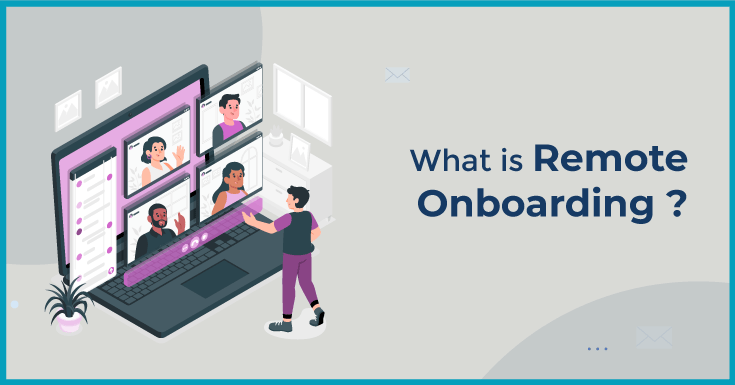There is now a before and after to remote work due to the coronavirus outbreak in 2020. In 2019, Flexjobs reported there to be 4.7 million remote workers in the U.S alone. Today, even with health authorities instituting vaccination programs, the number of businesses adopting a fully-remote or hybrid work arrangement is going up. Consequently, everything related to the workplace is going to be remote, from interviewing and hiring to remote onboarding.
Onboarding is crucial to helping new hires feel welcome. After all, no matter how experienced and competent an employee is, changing jobs and companies them into a new and unfamiliar environment. The point of remote onboarding is to make this transition easy for both the existing and new members.
In this post, we’ll go into what remote onboarding is and the best practices and tools to support, motivate and connect your virtual workforce. Read on!
1. What is Remote Onboarding?

The overall concept is the same whether the onboarding is in-person or remote; i.e. to welcome a new recruit on board. Remote onboarding comprises a series of activities that officially induct new hires into a company. It introduces them to departments and the teams that they will be working with closely. Onboarding programs also clue the existing workforce on who the new hire is, along with their designation and department.
Onboarding is important, whether or not your business has a dedicated recruitment and personnel department because it facilitates free-flowing conversations. The more immersive and interactive the onboarding experience, the less intimidating the first day at a new job feels. There are differences between collocated and remote onboarding.
For one, remote onboarding takes place entirely via video conferencing tools, ensuring that everyone on the team can clear their schedule on the appointed day to e-meet and greet the new joinee. The advantage here is that introductions can happen on the same day at the same time without unintentionally leaving anyone out.
Second, there’s reduced manual paperwork in favor of cloud and virtual documentation. Employee records are created in a central talent management tool while new recruits are given access to documentation concerning company policies, culture emphasis, governance, decorum, and contracts via company email. The same is also uploaded and stored on-Cloud such as Google-drive, so that important information is not lost in a torrent of emails that follow thereafter.
2. What happens in virtual onboarding?

The approach to onboarding remote employees cannot be a one-size-fits-all. Virtual onboarding has to be structured around a framework that captures the company’s core values, beliefs, and vision. The entry of new hire(s) should not blindside your current workforce, given that some or even all of them will have to interact and work with new people at some point down the line.
Put simply, virtual onboarding begins even before the new person joins. Emails are sent to departmental teams informing them of who is joining, and when. This has to be planned ahead so that announcements are not sudden. The objective is to prepare the existing team to e-meet the person.
3. How are companies doing virtual onboarding?

On the actual day and hour, virtual onboarding entails icebreaker and team building exercises that are entirely online. It's a good idea to brainstorm with current teams for suggestions to make the onboarding fun, useful and informative. This way, they feel included in the process even if they are geographically dispersed.
3.1 The Virtual Onboarding Process

Virtual onboarding starts with the onboarding facilitator announces the agenda for the e-meet. They then proceed to officially introduce all attendees. It's ideal that everyone turns their camera on for the duration of the session to make it more engaging. It is also easier for the new hire to put a face to the name as introductions are made. A series of questions follow to break the ice. Next, participants engage in the pre-planned games, quizzes and activities. Such exercises can not help new joinees overcome any nervousness and inhibitions but can also enable them to retain what they learn about the team and company.
The initial session should conclude by thanking everyone, and giving a shoutout to those who had a hand in devising the icebreakers and games. A day should also be dedicated to compiling relevant documentation for new hires, such as the company handbook, guides and booklets so that they are armed with sufficient documentation pre-joining.
It's easy to think that virtual onboarding is all about having fun, but there’s more to it than what meets the eye. There are challenges to combat as well, which we’ll go into in the next section.
4. Challenges of remote onboarding

The top 5 challenges of remote onboarding are;
4.1 Siloed communication
It gets chaotic if everyone uses different tools for the same purpose. Virtually, everything hinges on how stable and secure your internet connection is. With a small team, it's easier to steer the conversation back on-topic even if members drop in and out of ongoing interactions during a digital downtime.
This is practically impossible, however, when the team grows. You’ll find yourself having to repeat everything frequently, compounding your ability to get through the rest of the session and onboarding process.
What can you do about it?
Standardize the type, medium and frequency of usage for communication. Group members should all use the same tool so as to not have to waste time trying to find conversations that mention them. Keep in mind though, that mobile and desktop applications of the same tool may offer a different set of experiences in terms of logging in and getting notifications.
If members are unreachable for any reason, follow a stepwise process to find out what’s causing the holdup. For example, if you send out a message on Slack or Samepage and it is unseen beyond a reasonable time, call them with an in-tool option. Make sure to inform everyone of the steps in the process that they’ll be expected to follow so that they know when they’re supposed to revert. This will help keep communication real-time and in sync.
4.2 Coerced Camaraderie
Let’s face it; camaraderie online isn’t something that your team can just run with. It is easier for it to come out naturally when everyone is collocated rather than distributed. For one, the more comfortable you are with someone, the more you’ll want to interact with them. And this is more likely when you meet someone on a daily basis. What’s more, you can always visually confirm if someone’s available, free or busy.
Secondly, there are social, verbal and visual cues to help you respond and react to discussions, be them casual or work-related. Members can find common ground by reading these social signals. In a distributed and virtual set up, however, these cues are harder to read, particularly if most of the interactions are off-camera. Conversations can feel forced and invasive, especially when some or all of the members are absorbed in work. Busy members are likely to be irritable at what they consider unnecessary interruptions to their flow.
What can you do about it?
Don’t end the onboarding at just a one-off interaction. Try to make it to as many team stand ups as your work day will allow. The writing on the wall is clear; if managers can find the time to participate, so can everyone else.
Organize the work week by the number and relevance of catch ups so that work can stay on-track while also enabling different teams to maintain the rapport crucial to supporting each other.
4.3 Uncooperative Technology
We’ve all had days when umpteen technology glitches have disconnected you from ongoing calls. If this happens during virtual onboarding, it stretches the hour available and makes it difficult for everyone to stay in the loop.
What can you do about it?
Even with internet allowances, not much can be done when you work out of a remote location and rely on the only service provider there is. However, you can consider configuring offline settings to download call recordings, and back up chats routinely so that you can go back and catch up with what you have missed.
4.4 Monotonous Onboarding
I’ll be blunt here; company documentation is a yawn fest in the best of times. There are a lot of legal terms that remote workers may not feel the compulsion to read through entirely. Even if you send out information soft copies in time, there is the likelihood of either extreme; i.e. remote joinees may miss the mail or be unable to fully comprehend the material.
However, not making the time to go through the fine print can result in new joinees unintentionally breaking company rules.
What can you do about it?
If you want to make the documentation riveting, start by deciding on a common theme for a design facelift. You can apply this to all the material and break the content within into bite-sizes so that it's easier to read. Seeing a colorful package motivates a new hire to open and go through the attachments.
You could also consider gifting them a monogrammed goodies basket. If this falls out of your budget, you can opt to email them a store coupon or gift voucher instead. Such measures personalize the onboarding experience and help remote workers develop a genuine interest in the company that they are joining!
4.5 Unclear Expectations
Unclear expectations or expectations that keep changing, are a recipe for disaster. If they are not communicated to the concerned parties on time, it leads to the following issues;
- Missed goals
- Work overloads
- Time crunch
- More rework
- Disinterest
Consequently, the onboarding process appears scattered and not well thought out.
What can you do about it?
If you want your current and future workforce to stay on the same page, the first thing is to decide what your expectations are, and how you will go about conveying them. Have every document pertaining to the company’s tools, processes and people in one central location.
You can restrict access such that information stays internal but can also be circulated to the right people. Even if expectations change, these alterations or adjustments should also be communicated and reflected in timelines and quality so that the onboarding process doesn’t cause work to suffer.
5. The Remote Onboarding Checklist

Drawing up a remote onboarding checklist is the key to managers keeping the remote onboarding experience seamless. They can itemize what needs doing, and by when. Referring to this list ensures that you won’t forget something last-minute and can stay on top of the process. Here are some pointers to think about including when drafting your remote onboarding checklist;
5.1 Create a virtual document repository
Narrow down the list of documents pertinent to the new hire’s onboarding that you’ll require them to have. Typically this will comprise employee handbooks, task lists, contact information for different department heads, team members and assigned mentors. Store this in the virtual space for easier uploading, retrieval and updation. You can also get alerts as and when someone attempts to access documents and inspect activity logs to see which document was last opened.
5.2 Leveraging the right tools
Take inventory pre-joining to see if there are any equipment, hardware or software licenses you’re running low on. You can then order them ahead of the joinee’s arrival. If there is enough to go around, arrange to send out devices such as monitors and work laptops so that they can start using it with immediate effect.
Do remember to coordinate with the IT administrator to get the system up and running, and to set up work accounts and access to the company tools that the rest of the team are using.
5.3 Phasing out onboarding by role
Get the number and type of hires scheduled for onboarding and profile them by the department and seniority. Do this exercise even for contractual, casual and freelance remote workers.
Phasing out onboarding allows you to determine the length of time it’ll take and whether it merits having everyone introduced at once, or in stages.
For example, if three new hires belong to the same department, you can accordingly arrange for a day and hour that works to introduce them to their teammates, even if their joining dates differ from one another.
5.4 Administering Day One programs
Draw up a list of team building exercises to implement on Day One. Categorize them by difficulty levels (i.e. easy, moderate, champion) and arrange for prizes for the winners. You can also courier swag bags filled with branded merch in time for the actual onboarding. The unboxing itself can be an event and gives employees something to talk about!
5.5 Buddy system facilitation
Implementing a buddy system at-work can alleviate separation anxiety, particularly if someone has been working remotely for a while.
Assigning someone to handhold the new hire can help ease them into the organization and familiarize themselves with the way the company works, internal processes followed and tools in-use. Announce to your workforce that you’re initiating this program and that anyone interested can apply provided they can commit to it without the system adversely impacting their own work responsibilities.
5.6 Establish continuous checkpoints
Once the new remote hire is on-board, make sure to establish checkpoints after and as they move on to their role and tasks. Set a timebox for one-on-ones that enable them to give you feedback on how they are getting on so far, any challenges or issues they are experiencing, and what you would like them to do.
6. Virtual onboarding best practices

6.1 Create a clear onboarding roadmap
Define both short and long-term goals and share these with both current and new employees. It reiterates what the priorities are, and enables them to work cohesively to meet goals and perform to the standard expected of them. Creating an onboarding roadmap makes it easy for the manager leading the team and the new contributor.
6.2 Curate a starter employee kit
What information would you like your new hires to have beforehand, during and after the onboarding? A starter pack can help you accordingly decide which documents to send out in phases. This is preferable to overloading your remote employee with information and subsequently confusing them. The starter kit should summarize the company’s success, highlights as well as offer insights into the role. You can also include excerpts from employees who were previously in similar roles to give new joinees insights into the growth trajectory. This last bit answers questions they might have about how the role they are hired for will evolve.
6.3 Set up access to business communication
Walk new hires through work accounts and have them test out their equipment, devices and email accounts to ensure everything is in working order. Inform them of the best ways to get in touch with relevant departments and provide troubleshooting guides in case they run into errors using their email, messaging or conferencing platforms. Make sure remote workers are aware of their tasks and who will be delegating them. They can then contact relevant personnel for clarifications concerning deadlines and priorities.
6.4 Introduce the new hire to departments
Plan out in advance how and when you’ll be doing the introductions. Remember to give existing teams a heads up so that they can finish what they are on and make themselves available to be introduced.
6.5 Introduce the assigned buddy
You can opt to introduce the buddy in the same meeting as the initiation, or on a different day so as to make it easier for the new hire to remember names, faces and designation.
6.6 Create cohorts for large-scale onboarding
A cohort cluster onboards new joinees in bulk, which reduces the effort and duplications. It also enables joinees to form a community online wherein they can find projects of interest to work together on. Large-scale onboarding also reduces the time to deploy and train new hires for work. You can appoint a group representative for different cohorts who will be the point of contact for getting and giving feedback on the cohort’s collective and individual performance.
6.7 Organize virtual coffee meets
Schedule online meet ups using tools such as Slack, Coworker coffee or theleancoffeetable once the induction ends to catch up with your new hire. Ask them if they’d prefer doing this one-on-one or with their assigned buddy present. Breaking the interactions into smaller meets makes it easier for people to open up about their experience so far, and gives you a more realistic picture of what they are dealing with.
6.8 Introduce formal and informal learning
Formalize training measures and roll them out in line with progress reports. The training can be a mix of formal and informal learning so that the new hire can take the time to acquire mastery over a new area. Informal learning through peer discussions, buddy and reverse mentoring breaks stereotypes such as senior staff being averse to learning from someone junior to them in years or experience. Formal onboarding on the other hand, entails conducting learning exercises via virtual events, workshops, tutorials and in-house academies
6.9 Ask for onboarding feedback
From an employee's perspective, an onboarding program should get them used to two things; working virtually in a new environment with new teams, tools and processes. Collecting feedback from the people who joined most recently can also clue you in where the remote onboarding fell short. Any gaps can be fixed, improved or even changed completely so that the next person who joins has no confusion or complaints!
Lastly, onboarding should be a very personal experience. It’s your new hire’s first day at your company, so you want to engage them from day-one. Without face-to-face time, it can be even more challenging to bring them into the fold and make them feel part of the team.
7. Remote onboarding tools

There are onboarding tools created specifically to weave new joinees into the core of the new organization that they are now a part of. Some tools besides the trusty Slack, are:
| Tool | Features | Pricing |
| Start up $59
Scale up $199 | |
| Essential $26WorkHub $37 Sales Hub $37 Ultimate - Contact Sales $37 | |
| Pro Pro+Coaching -Contact Sales | |
| Per Check $2.5
| |
| Starter $46
|
8. How do you do virtual onboarding?

Virtual onboarding should be personal, inviting and interesting. The trouble with remote work is that work priorities take precedence over intentional conversationals. In other words, not everyone finds it possible to maintain a rapport with their colleagues consistently.
When you’re in a physical workspace, you can strike up a conversation and take conscious breaks around the watercooler. Online however, you can fall in either extreme; you’ll either be too preoccupied with work and zone out, or spend more time in multiple chat groups than work. It's all about finding a balance.
The truth is, virtual onboarding benefits employers and employees. Employers can take new recruits through how the company works. It lets them learn what your company culture stands for, and enables them to make their acquaintance with team members they will be working with. This makes the next steps of taking up work and growing skills easier on your recruit.
The key to doing virtual onboarding is to structure it around convenience and convictions. The intent is to include everyone and ensure new employees fit right in with the team. Team members can also make the transition easy for the latest addition to the team by mentoring and guiding them, recounting their own experiences and even gaining a different and new perspective from the joinee!
How did your remote onboarding experience go, and what would you want done differently if you could do it all over again?
 Interested in Virtual Team Building Events?
Interested in Virtual Team Building Events?




























